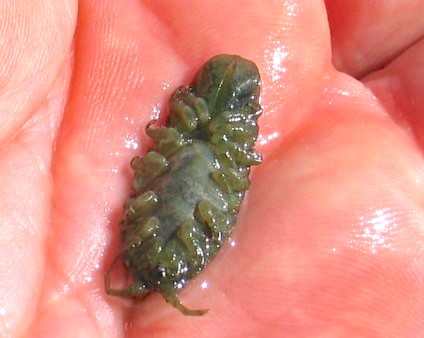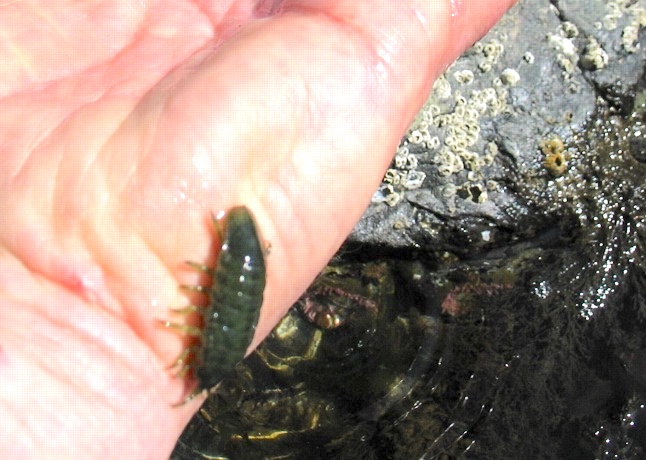| 1– Global Distribution: Ranges from Alaska (and Russia) to Estero Bay, San Luis Obispo County.
2- Habitat: You can find it under rocks, under cobble at the edges of tide pools, in blades of seaweed, attached to floats and on eelgrass. Hangs onto holdfasts stalks, worm tubes and other objects. But the most common place is under rocks on the shore.
3- Physical Description: They are large isopods, measuring up to 3-4 cm long and quite dark. Generally their color is olive-green but it may vary from bright green to brown or nearly black. The abdominal region is mostly unsegmented and their terminal portion is rather smoothly rounded, except for a tiny blunt tooth at the tip See the ventral image on the left.
4- Feeding: It feeds on algal detritus and reproductively mature plants, but avoids non-fertile individuals. It doesn’t eat immature plants by the algae’s cuticle.
5- Predators: Other arthropods and invertebrates, fishes, birds, reptiles and mammals.
6- Reproduction: “During reproduction, the male isopod carries the female for a short period known as pre-copula which lasts until the moult at which time copulation occurs. The sperm are transferred from the male to the female genital duct. In most species, the female releases the eggs into a ventral brood chamber where they are incubated until after hatching.” Idotea wosnesenskii incubate their eggs and juveniles in pockets of the body which open from the brood chamber. “Unlike crabs and shrimps isopods are not released as free-swimming zoea larva. Instead, when hatched they look very much like adults but have 6 rather than 7 pereonal segments. Some species care for their young after leaving the chamber but most species do not.” (Quoted from source b)
7- An Interesting Fact: It does not look like much of a swimmer, but it is surprisingly agile and graceful when it does swim. The paddlelike appendages on the underside of its abdomen propel it with seeming effortlessness, while the legs are spread as if to take hold of any firm object that comes along |
 The Race Rocks taxonomy is a collaborative venture originally started with the Biology and Environmental Systems students of Lester Pearson College UWC. It now also has contributions added by Faculty, Staff, Volunteers and Observers on the remote control webcams. This file was originally written by Claudia Aliaga, Chile, Pearson College student , Year 32 -2006
The Race Rocks taxonomy is a collaborative venture originally started with the Biology and Environmental Systems students of Lester Pearson College UWC. It now also has contributions added by Faculty, Staff, Volunteers and Observers on the remote control webcams. This file was originally written by Claudia Aliaga, Chile, Pearson College student , Year 32 -2006

